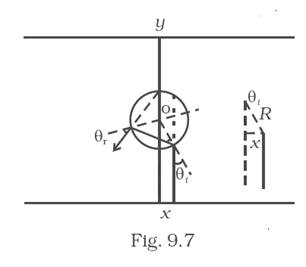An infinitely long cylinder of radius R is made of an unusual exotic material with refractive index –1 (Fig. 9.7). The cylinder is placed between two planes whose normal are along the y direction. The center of the cylinder O lies along the y-axis. A narrow laser beam is directed along the y direction from the lower plate. The laser source is at a horizontal distance x from the diameter in the y direction. Find the range of x such that light emitted from the lower plane does not reach the upper plane.

The range of x such that light emitted from the lower plane does not reach the upper plane ![]()
Given:
The radius of the cylinder = R, the refractive index of the cylinder = -1, placed in a y-axis coordinate with center at zero, the angle of incidence is ![]() and the angle of refraction is
and the angle of refraction is![]() . The distance at which the cylinder is kept on y-axis is x.
. The distance at which the cylinder is kept on y-axis is x.
Formula used:
Snell’s Law, is the ratio between the sine value of incidence and refraction with the ratio of refractive index of the mediums through which the light passes.
![]()
where
![]() is the refractive index of the medium,
is the refractive index of the medium, ![]() is the refractive index of the air
is the refractive index of the air![]() . i is the angle of incidence and r is the angle of refraction
. i is the angle of incidence and r is the angle of refraction
Explanation:
The angle at which the rays will not reach the cylinder is from![]() . The refracted ray coming out of the cylinder is
. The refracted ray coming out of the cylinder is![]() . Therefore, the range for the angle of refraction in terms of angle of incidence is
. Therefore, the range for the angle of refraction in terms of angle of incidence is
![]()
![]()
![]()
![]()
![]()
Now the above range of x or where the cylinder should be kept to not get light on the plates is ![]() .
.